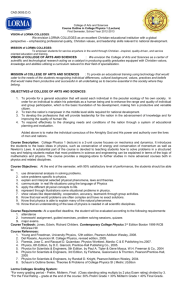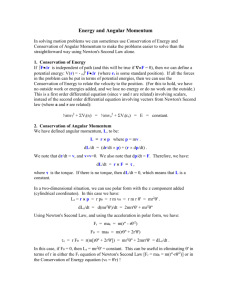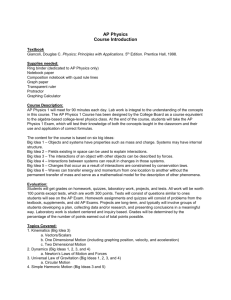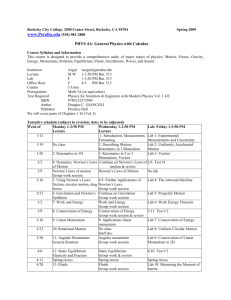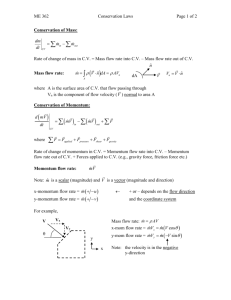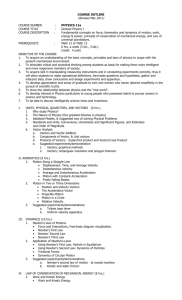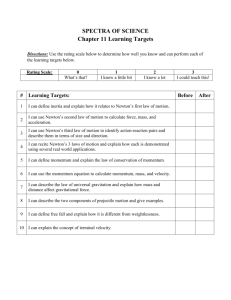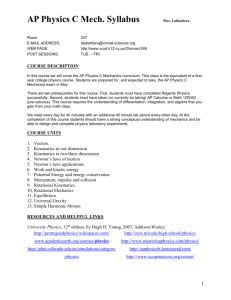Syllabus - Pellissippi State Community College
advertisement
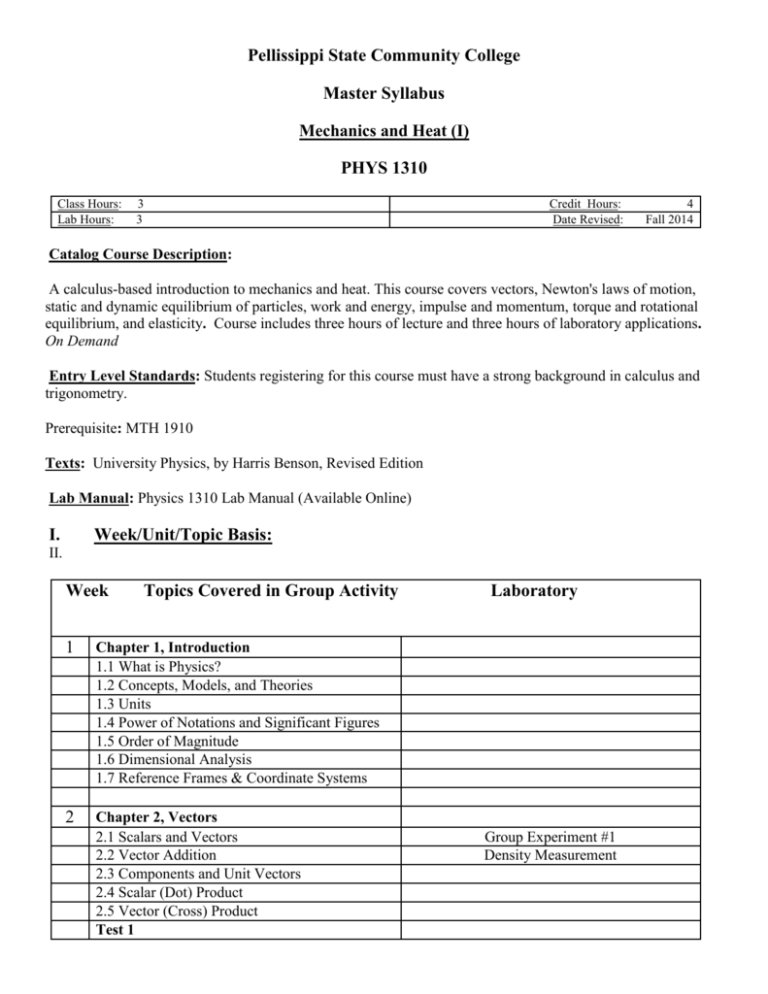
Pellissippi State Community College Master Syllabus Mechanics and Heat (I) PHYS 1310 Class Hours: Lab Hours: 3 3 Credit Hours: Date Revised: 4 Fall 2014 Catalog Course Description: A calculus-based introduction to mechanics and heat. This course covers vectors, Newton's laws of motion, static and dynamic equilibrium of particles, work and energy, impulse and momentum, torque and rotational equilibrium, and elasticity. Course includes three hours of lecture and three hours of laboratory applications. On Demand Entry Level Standards: Students registering for this course must have a strong background in calculus and trigonometry. Prerequisite: MTH 1910 Texts: University Physics, by Harris Benson, Revised Edition Lab Manual: Physics 1310 Lab Manual (Available Online) I. Week/Unit/Topic Basis: II. Week Topics Covered in Group Activity 1 Chapter 1, Introduction 1.1 What is Physics? 1.2 Concepts, Models, and Theories 1.3 Units 1.4 Power of Notations and Significant Figures 1.5 Order of Magnitude 1.6 Dimensional Analysis 1.7 Reference Frames & Coordinate Systems 2 Chapter 2, Vectors 2.1 Scalars and Vectors 2.2 Vector Addition 2.3 Components and Unit Vectors 2.4 Scalar (Dot) Product 2.5 Vector (Cross) Product Test 1 Laboratory Group Experiment #1 Density Measurement 3 4 5 6 7 8 Chapter 3, One-Dimensional Kinematics 3.1 Particle Kinematics 3.2 Displacement and Velocity 3.3 Instantaneous Velocity 3.4 Acceleration 3.5 The Use of Areas 3.6 The Equation Kinematics for Constant Accel. 3.7 Vertical Free-fall 3.8 Terminal Speed Chapter 4, Inertia and 2-D Motion 4.1 Newton's First Law 4.2 Two-dimensional Motion 4.3 Projectile Motion Test 2 Chapter 4, Continued.... 4.4 Uniform Circular Motion 4.5 Inertial Reference Frames 4.6 Relative Velocity 4.7 The Galilean Transformation 4.8 Nonuniform Circular Motion Chapter 5, Particle Dynamics I 5.1 Force and Mass 5.2 Newton's Second Law 5.3 Weight 5.4 Newton's Third Law 5.5 Applications of Newton's Laws 5.6 Apparent Weight Test 3 Chapter 6, Particle Dynamics II 6.1 Friction 6.2 Dynamics of Circular Motion 6.3 Satellite Orbits Chapter 7, Work and Energy 7.1 Work Done by a Constant Force 7.2 Work done by a Variable Force 7.3 Work-Energy Theorem in One Dimension 7.4 Power Test 4 Group Experiment #2 Addition of Vectors Graphical Method Group Experiment #3 Addition of Vectors Forces (The Force Table) Group Experiment #4 Measurement of "g", The Acceleration of Gravity Group Experiment #5 Centripetal Force Group Experiment #6 Coeff. of Kinetic Friction Group Experiment #7 Newton's Second Law 9 10 Chapter 8, Conservation of Mechanical Energy 8.1 Potential Energy 8.2 Conservative Forces 8.3 Potential Energy and Cons. Forces 8.4 Potential Energy Function 8.5 Conservation of Mechanical Energy 8.6 Mech. Energy and Non-conservative Forces 8.9 Gravitational Potential Energy Chapter 9, Linear Momentum 9.1 Linear Momentum 9.2 Conservation of Linear Momentum 9.3 Elastic Collision in One Dimension 9.4 Impulse Test 5 Group Experiment #8 Conservation of Energy Group Experiment #9 Conserv. of Linear Momentum 11 Chapter 9, Continued... 9.5 Comparison of L. Momentum with K.E. 9.6 Elastic Collision in 2-D 9.7 Rocket Propulsion Group Problem Session 12 Chapter 10, Systems of Particles 10.1 Center of Mass 10.2 Center of Mass of Continuous Bodies 10.3 Motion of Center of Mass 10.4 Kinetic Energy of a System of Particles 10.5 Work-Energy Theorem for a System of Particles 10.6 Work Done by Friction Test 6 Group Experiment 10 Static Equilibrium of a Particles (The Crane Boom) 13 Chapter 11, Rotation About a Fixed Axis 11.1 Rotational Kinematics 11.2 Rotational K.E., Moment of Inertia 11.3 Moment of Inertia of Cont. Bodies Group Problem Session 14 Chapter 11, Continued... 11.4 Conservation of Mechanical Energy 11.5 Torque 11.6 Rotational Dynamics of a Rigid Body 11.7 Work and Power 15 Final Exam Period Group Problem Session II. Course Goals*: The objective of this course is to familiarize students with the principles of physics as basis for their continuation of studies in Science and Medical profession. At work sites, the graduates often need to work with equipment that work by the virtue of physics principles. Examples are traction equipment, X-ray machines, sonogram, blood pressure measurement devices, etc. The examples and problems selected for the course give the students the necessary knowledge and skills to read and analyze scientific data with proper understanding of the units involved and the type of physical quantity measured. The first few chapters lay down the foundation that is absolutely necessary to understand the physical quantities that appear in later chapters and are often seen on equipment used in medicine or industry. On this basis, after finishing this course, students will be able to: A explain Metric and American units and systems and perform various conversions between the two, (The gauges at work sites often use both types of units),(V.1 & V.3) B Describe the motion of a body and calculate the necessary parameters by using equations of motion in a practical situation,(V.1 & V.4) C Analyze force-motion relations in a practical situation ,(V.1 & V.4) D calculate the work done by a force as well as energy calculations and conversion to heat (calories),(V.1 & V.4) E explain different forms of energy and their conversion to each other as well as the Principle of Conservation of Energy in practical situations at work sites,(V.1, V.2, V.3,& V.4) F apply the laws of conservation of energy and momentum, (V.2, V.3,& V.4) G calculate the parameters involved in the motion of a rotating object such as particle separators (centrifugal separating devices),(V.2 & V.4) H apply the laws of fluid pressure and density to measure the necessary parameters in a practical situation at work, (V.1 & V.3) I make temperature measurements in different scales and convert and use them for heat and energy calculations with or without phase change,(V.3) J apply the equations for thermal expansion of solids, liquids, and gases, (V.3) K Describe oscillatory motion by measuring wavelength, amplitude, and the phase of motion of mechanical waves such as sound, (V.1 & V.3) L apply the knowledge of sound parameters such as frequency, wavelength, and in interpreting the signals on measurement devices in sonogram and ultrasound, (V.3) M apply the conditions of static equilibrium to find the forces acting on an object in a given situation, (V.1 & V.3) and N use the concept of torque of a force to analyze the static equilibrium of a rigid body. (V.3) * Roman numerals after course goals reference the stipulated outcomes of Natural Science programs under General Education Goals. III. Expectations for Student Performance:* 1 2 3 4 5 6 7 8 9 Upon successful completion of this course, the student should be able to: apply the physics concepts to theoretical and practical situations (A through K), estimate an unknown parameter in a given practical situation by using the physics principles involved, (B, D, E, F, G, H, and I), recognize and identify the use of equipment and machines from the units used in their gauges, (A), master energy calculations to estimate energy requirement and feasibility in a given situation, (D, E, and F), perform necessary conversion between Metric and non-metric units and systems (A), apply the kinematics equations to describe motion, (B and C), apply the kinetics equation in force-motion situations (B and C), calculate the work done, energy involved, and energy conversions in a given problem (D, E, and F), solve problems involving circular motion as well as torque, energy, and momentum calculations (E, F, and G), solve temperature and heat problems with or without phase change, (I), solve problems involving heat effect and thermal expansion in solids, fluids, & gases (J), solve problems in oscillatory motion in order to find the parameters involved (K and L), solve and analyze fluid pressure, air pressure, and density problems (H), apply a vector approach where vector quantities are involved (M), resolve a vector into two components graphically and analytically (M), and apply force and torque equilibrium concepts in solving rigid-body problems (M, N, and O). 10 11 12 13 14 15 16 * Capital letters after Expected Student Learning Outcomes reference the course goals listed above. IV. Evaluation: Students are primarily evaluated on the basis of test/quiz type assessments and homework as outlined on the syllabus and supplement distributed by the instructor. The following formula is used to evaluate the course grade: A Course Grade = (0.75)x(Theory Grade) + (0.25)x(Lab Grade) Theory Grade = 0.80(Tests + Quizzes + H.W. ) + 0.20(Comprehensive Final) B Tests count (80%), quizzes (10%), and homework (10%). The number of tests may vary from 5 to 7. The percentages given for tests, quizzes, and homework may vary depending on the instructor. Laboratory Grade = (the sum of reports grades) / (the number of the reports). C D E 10 experiments* are designed for the course. Each experiment requires a report that must be at least spell-checked. Procedures for a standard lab report will be given by your instructor. To avoid a ZERO Laboratory Grade, at least 6 reports must be turned in. No late lab report(s) will be accepted and there are No Lab Make-ups. Site Visits: The necessary site visits will be announced as the arrangements are made. Evaluation will be based on of attendance as well as the visit report. Grading Scale: (91-100: A), (87-91: B+), ( 81-87 : B), (77-81: C+), (70-77:C), and (60-70: D) V. Policies: A. Attendance Policy: Pellissippi State expects students to attend all scheduled instructional activities. As a minimum, students in all courses (excluding distance learning courses) must be present for at least 75 percent of their scheduled class and laboratory meetings in order to receive credit for the course. Individual departments/programs/disciplines, with the approval of the vice president of the Learning Division, may have requirements that are more stringent. In very specific circumstances, an appeal of the policy may be addressed to the head of the department in which the course was taken. If further action is C. ACCOMMODATIONS FOR DISABILITIES Students who need accommodations because of a disability, have emergency medical information to share, or need special arrangements in case the building must be evacuated should inform the instructor immediately, privately after class or in her/his office. Students must present a current accommodation plan from a staff member in Services for Students with Disabilities (SSWD) in order to receive accommodations in this course. SSWD may be contacted by going to Goins 127, 132, 134, 135, or 131 or by phone: 694-6429 (Voice/TTY) or 539-7153. More information is available at www.pstcc.edu/departments/swd/ Emergency College Closing: If for any reason the college has to close for any number of days, it is your responsibility to study and follow the syllabus as if you are attending classes. You should frequently check your email and follow the instructions given by your instructor as how and when tests will be given. For laboratory experiments, our existing physics applets on our NBS Website will be used. You will perform online experiments and email your reports. ATTENTION FINANCIAL AID AND/OR HOPE SCHOLARSHIP RECIPIENTS: Maintaining continuous attendance in your classes is very important. If you are considering dropping or withdrawing from a course, please check with the Financial Aid Office before doing so. Dropping or withdrawing from a class can adversely affect your financial aid and/or lottery eligibility. D. Final Exam: Final Exam must be taken during the Final Exam Week. No early Final Exam will be given. E. Lab Reports: No late lab report will be accepted and there are No Lab Make-ups Clicks to get to Chapters: At www.pstcc.edu, click on 1- Academics 2- Academic Departments 3- Natural and Behavioral Sciences 4- Course Information - On the line for PHYS 1310 you may click on Chapters, Syllabus, Experim., etc... Experiments: 1 2 3 4 5 Measurement and Density Addition of Vectors (Graphical Approach) Addition of Vectors ( Force Table) Measurement of "g", The Acceleration of Gravity Centripetal Force 6 7 8 9 10 Coefficient of Kinetic Friction Newton's Second Law Conservation of Energy Conservation of Linear Momentum Static Equilibrium (The Crane Boom)
